Introduction
Garden spurge (Euphorbia hirta) is a prostrate (low-growing), herbaceous, short-lived, warm-season annual weed commonly found in Florida landscapes, container nurseries, and other agricultural production areas. This article is written to aid green industry professionals and others in the identification and management of garden spurge in and around ornamental plants.
Species Description
Class
Dicotyledon
Family
Euphorbiaceae—Spurge family
Other Common Names
Pillpod sandmat, asthma spurge, asthma weed, hairy spurge
Life Span
Warm-season annual
Habitat
Garden spurge (Figure 1) is a common weed in agriculture fields, container-grown ornamentals, landscape planting beds, lawns, gardens, and other disturbed areas. In container nurseries, garden spurge can be found in containers, in pot drain holes, growing through weed mats, and in non-crop areas around the nursery. In landscapes, it is frequently found growing in turfgrass or in mulched planting beds, but it is also commonly found growing in sidewalk cracks and between patio pavers. Garden spurge prefers warm and sunny locations but can also grow in dense shade.
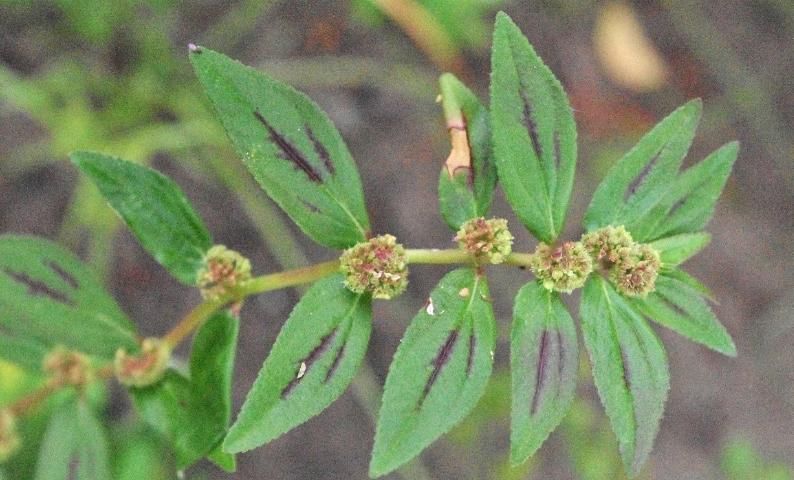
Credit: Annette Chandler, UF/IFAS
Distribution
Garden spurge is native to tropical and subtropical regions of North America but has naturalized throughout tropical and subtropical areas throughout the world (USDA-NRCS 2020). In the United States, garden spurge is commonly found in the southeastern states, as far north as North Carolina and west to California (USDA-NRCS 2020). Current distribution outside the US includes South and East Asia, the Pacific Islands, Australia, and pan-tropical America (Queensland Government 2016).
Growth Habit
Garden spurge is a low-growing (prostrate) herbaceous annual plant. Stems are prostrate to ascending, and may reach 6 to 20 inches in length. Garden spurge stems arise from a central taproot and are reddish purple and covered with yellowish to dark brown hairs. Vegetative tissue (stems, leaves, etc.) discharges a milky latex sap when broken (Neal and Derr 2005).
Seedling
Garden spurge seedlings are green to reddish in color with opposite leaves that are obovate (narrow leaves at the base) with small serrations (teeth) around the leaf edges (Figures 2 and 3) (Molinar et al. 2009; Invasive Species Compendium 2019).
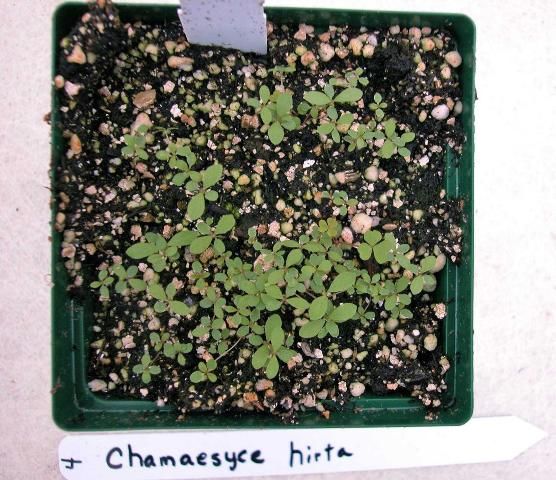
Credit: Annette Chandler, UF/IFAS
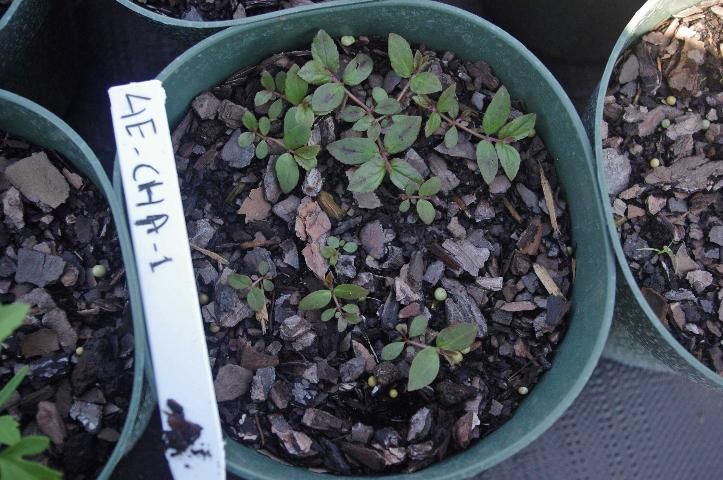
Credit: Annette Chandler, UF/IFAS
Shoot
Stems emerge from a central taproot. They are reddish to purple in color and coated with dense yellow hairs. When found in heavy shade, leaves may be more greenish in color. Stems and leaves contain a milky latex sap. Leaves are opposite and oblong to lanceolate in shape with a pointed tip. Finely serrated (toothed) margins are typically 0.5 to 1.5 inches long (Invasive Species Compendium 2019). Leaves may have a reddish/purplish spot.
Roots
Garden spurge has a main taproot that can reach up to 24 inches in length but is usually around 4 to 6 inches long. The rest of its root mass consists of secondary fibrous roots growing off the main taproot. Garden spurge does not usually root at nodes. Spread is mostly through seed production (Invasive Species Compendium 2019).
Inflorescence
Flowers (cyathia-type flowers) are very small and emerge from the leaf axils in a round, globular-like cluster on top of the stems. The clusters of flowers are usually 0.2 to 0.4 inches in diameter, and may be tan to greenish to pinkish in color. Flowers are monoecious (both male and female flower structures) and have no petals, consisting only of stamens and pistils with a brown peduncle (stem that connects the flowers to the stem) (Invasive Species Compendium 2019).
Fruit and Seeds
Fruits are 3-lobed and split into 3 one-seeded segments. One mature plant can produce several thousand seeds over the course of just 8 to 10 weeks. Fruit are tan in color and measure approximately 0.05 to 0.08 inches by 0.06 inches. Seeds are oblong and very small with a reddish-brown color (Invasive Species Compendium 2019).
Similar Species
As a group, the spurges (Euphorbia spp.) are the most common broadleaf weeds in container nurseries in the southeastern United States with over 30 species documented in Florida (Wunderlin et al. 2020). Of all the spurge species, three are generally most common in landscapes and nurseries: garden spurge, spotted spurge (Euphorbia maculata), and hyssop spurge (Euphorbia hyssopifolia). Hyssop spurge can be differentiated from garden spurge because it tends to have rounder leaves and has an upright growing habit (Figure 4). Garden spurge and spotted spurge have the same prostrate growth habit, but spotted spurge leaves are much rounder in shape than those of garden spurge and are usually about half their size (Figure 5).
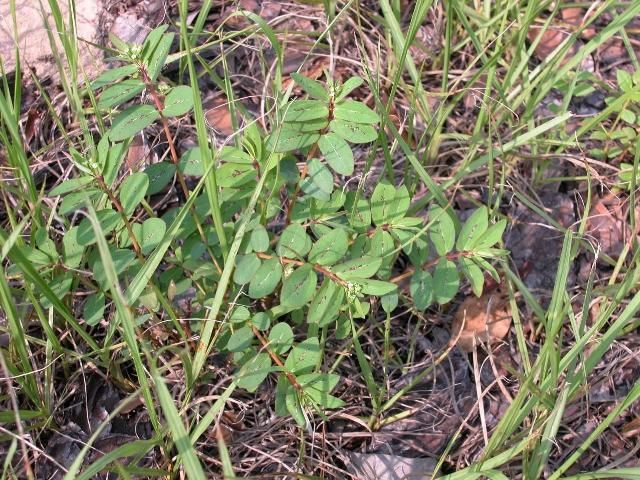
Credit: Annette Chandler, UF/IFAS
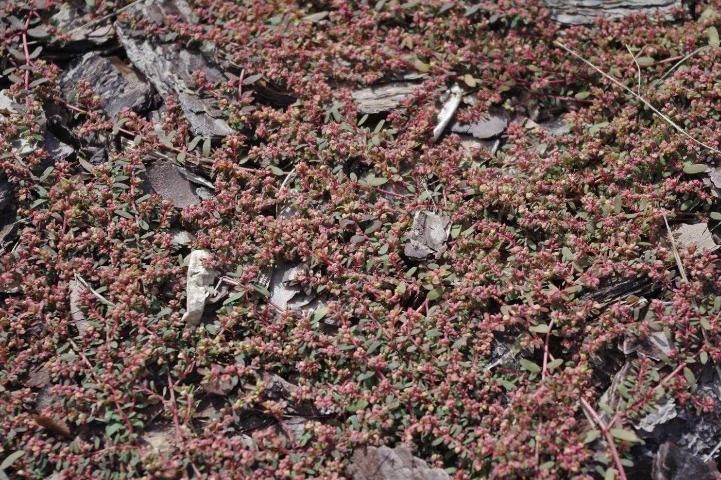
Credit: Annette Chandler, UF/IFAS
Plant Biology
Garden spurge is one of the most common weeds in Florida landscapes and container nurseries. Seed germination is highest at temperatures between 75°F and 85°F but can occur any time temperatures are over 60°F. In central and south Florida, germination occurs throughout most of the year while germination is limited to spring and summer in cooler climates. Plants can begin to produce seeds in as little as 6 to 8 weeks after germination. Garden spurge seeds have no dormancy requirement, meaning that once seeds are mature, they are viable; they begin to germinate and grow once they are dispersed (Neal and Derr 2005). In landscapes and nurseries, seeds are often spread by wind, water, and mowing equipment.
Management
Physical and Cultural Control
In landscapes, mulch such as pine bark or pine straw applied at a depth of 2 to 3 inches can prevent garden spurge emergence because its seeds require light to germinate (Saha et al. 2019). Because garden spurge does not root along its nodes, it can usually be removed effectively by hand-weeding. Hoeing, tilling, and raking control emerged shoots, but these are often not practical in most landscape situations. Mowing is generally not an effective management approach due to garden spurge's low prostrate growth habit (Thralls 2019). In nurseries, mulches such as pine bark nuggets, rice hulls, or other mulch materials that dry quickly after irrigation offer control. Hand-weeding is also effective, but it is important to hand-weed frequently (every 2 to 4 weeks) because of garden spurge's fast growth rate and its ability to quickly produce seeds following germination.
Chemical Control
Most postemergence herbicides that have activity on broadleaf weeds offer control of garden spurge. Systemic herbicides such as glyphosate (RoundUp® and many other trade names) can be used on large established plants, and would be recommended in cases where the area was heavily infested with spurge and other weed species. Because garden spurge is an annual weed, contact herbicides such as diquat (Reward®) and glufosinate (Finale®) are highly effective if coverage is thorough. For a complete list of postemergence herbicide options labeled for use in nurseries and landscapes, see EDIS document ENH95, Postemergent Herbicides for Use in Ornamentals. In container-grown ornamentals, garden spurge is managed most successfully with preemergence herbicides because no over-the-top broadleaf postemergence herbicides are available for use. Even in cases where postemergence herbicides can be used, such as in landscape beds, preemergence herbicides are often recommended to prevent reinfestation due to garden spurge's fast growth rate and high seed production. Effective active ingredients include dimethenamid-P, indaziflam, flumioxazin, and herbicide combinations that include one of these active ingredients. Table 1 shows a list of preemergence herbicides labeled for use in landscapes and production ornamentals, including example trade names, application rates, and efficacy rankings for garden spurge.
References
Invasive Species Compendium. 2019. "Data Sheet Euphorbia hirta (Garden Spurge)." CABI. Accessed January 9, 2020. https://www.cabi.org/isc/datasheet/21355#F56A69A1-CDEF-4FC0-B00C-A17039BDBEE5
Jabeen, N., and A. Moinuddin. 2009. "Possible Allelopathic Effect of Three Different Weeds on Germination and Growth of Maize (Zea mays) Cultivars." Pak. J. Bot. 41: 1677–1683.
Molinar, R. H., D. W. Cudney, C. L. Elmore, and A. Sanders. 2009. "Pest Notes: Spurge and Other Spurges." UC ANR Publ. No. 7445. Accessed January 20, 2020. http://ipm.ucanr.edu/PMG/PESTNOTES/pn7445.html
Neal, J. C., and J. F. Derr. 2005. Weeds of Container Nurseries in the United States. Raleigh, NC: North Carolina Assoc. of Nurserymen, Inc.
Queensland Government. 2016. "Fact Sheet Index." Weeds of Australia Biosecurity Queensland Edition. Accessed January 9, 2020. https://keyserver.lucidcentral.org/weeds/data/media/Html/chamaesyce_hirta.htm
Saha, D., S. C. Marble, B. J. Pearson, H. E. Perez, G. E. MacDonald, and D. C. Odero. 2019. "Weed Seed Emergence and Growth in Response to Different Physical Properties of Common Landscape Mulch Materials." Weed Technology. Accessed January 20, 2020. https://doi.org/10.1017/wet.2019.88
Thralls, E. 2019. "Weed Wars." UF/IFAS Blogs. Accessed January 10, 2020. https://blogs.ifas.ufl.edu/orangeco/2019/04/19/weed-wars/
USDA, NRCS. 2020. "The PLANTS Database." Accessed January 20, 2020. https://plants.usda.gov
Wunderlin, R. P., B. F. Hansen, A. R. Franck, and F. B. Essig. 2020. "Atlas of Florida Plants." Accessed January 20, 2020. https://florida.plantatlas.usf.edu
This table lists registered pesticides that should be integrated with other pest management methods. Additional information on integrated pest management methods can be requested from UF/IFAS Extension horticulture or agriculture agents. A list of local UF/IFAS Extension county offices is available at https://ifas.ufl.edu/. Contact: Weed specialist (Chris Marble, UF/IFAS Mid-Florida Research and Education Center, marblesc@ufl.edu).